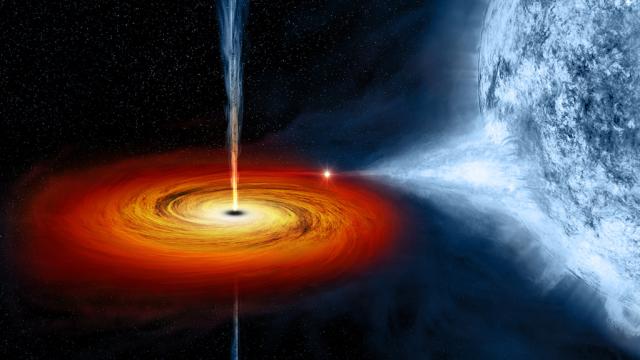Don’t get me wrong, black holes are cool, but they’re also giant voids of terror: These gravitational abysses have been known to snack on stars in occurrences called Tidal Disruption Events (TDEs). It’s always the same horror story — an unsuspecting star wanders too close to a black hole, only to get ripped apart by the black hole’s gravity. Isn’t space pleasant?
Image: NASA
Traditionally, astronomers have searched for TDEs in sky surveys that encompass thousands of galaxies, leading them to believe that these events were extremely rare — only one tidal disruption every 10,000 to 100,000 years per galaxy. But after observing a likely TDE in a sky survey of just 15 galaxies, a team of researchers at the University of Sheffield in the UK has concluded black holes may be ripping up stars 100 times more often than previously assumed, based on this relatively small sample size. Their research was published today in Nature Astronomy.
“Each of these 15 galaxies is undergoing a ‘cosmic collision’ with a neighbouring galaxy,” Dr James Mullaney, Lecturer in Astronomy and co-author of the study, said in a press release.
“Our surprising findings show that the rate of TDEs dramatically increases when galaxies collide. This is likely due to the fact that the collisions lead to large numbers of stars being formed close to the central supermassive black holes in the two galaxies as they merge together.”
Earlier this month, a team of researchers released their findings on the longest-recorded TDE, which clocked in at 10 years. While we can’t normally see black holes — as they swallow everything, light included — we can see flare ups of energy as stars are in the process of being devoured. Learning more about the destructive tendencies of black holes today will give us a better understanding of how they will shape the cosmos in the future, especially within our own galaxy.
“Based on our results for [a galaxy known as] F01004-2237, we expect that TDE events will become common in our own Milky Way galaxy when it eventually merges with the neighbouring Andromeda galaxy in about 5 billion years,” Clive Tadhunter, Professor of Astrophysics and lead author of the study, said in a press release.
“Looking towards the center of the Milky Way at the time of the merger we’d see a flare [from a tidal disruption event] approximately every 10 to 100 years. The flares would be visible to the naked eye and appear much brighter than any other star or planet in the night sky.”
It’s worth noting that this is just one study, which came to its conclusions based on a single TDE, which still needs to be confirmed by further investigation. There’s a lot more work to be done if we want to truly nail down the behaviour of these elusive beasts.
“First, let me say that finding a TDE in a starburst galaxy, as these authors seem to have done, is an important discovery, as it has never been seen before,” Nicholas Stone, a postdoctoral Einstein Fellow in the Columbia Astrophysics Laboratory, told Gizmodo. “However, I think more follow-up observations may be necessary to confirm this TDE candidate as a true TDE. In particular, I am a little concerned by the possible late-time increase in luminosity in this flare, which would not be expected for most TDEs. Further monitoring of this galaxy can ascertain whether the flare is re-brightening or dimming.”
Ah, the brightening and dimming of a star’s abbreviated life. Cheers to many more years of stellar cannibalism!
